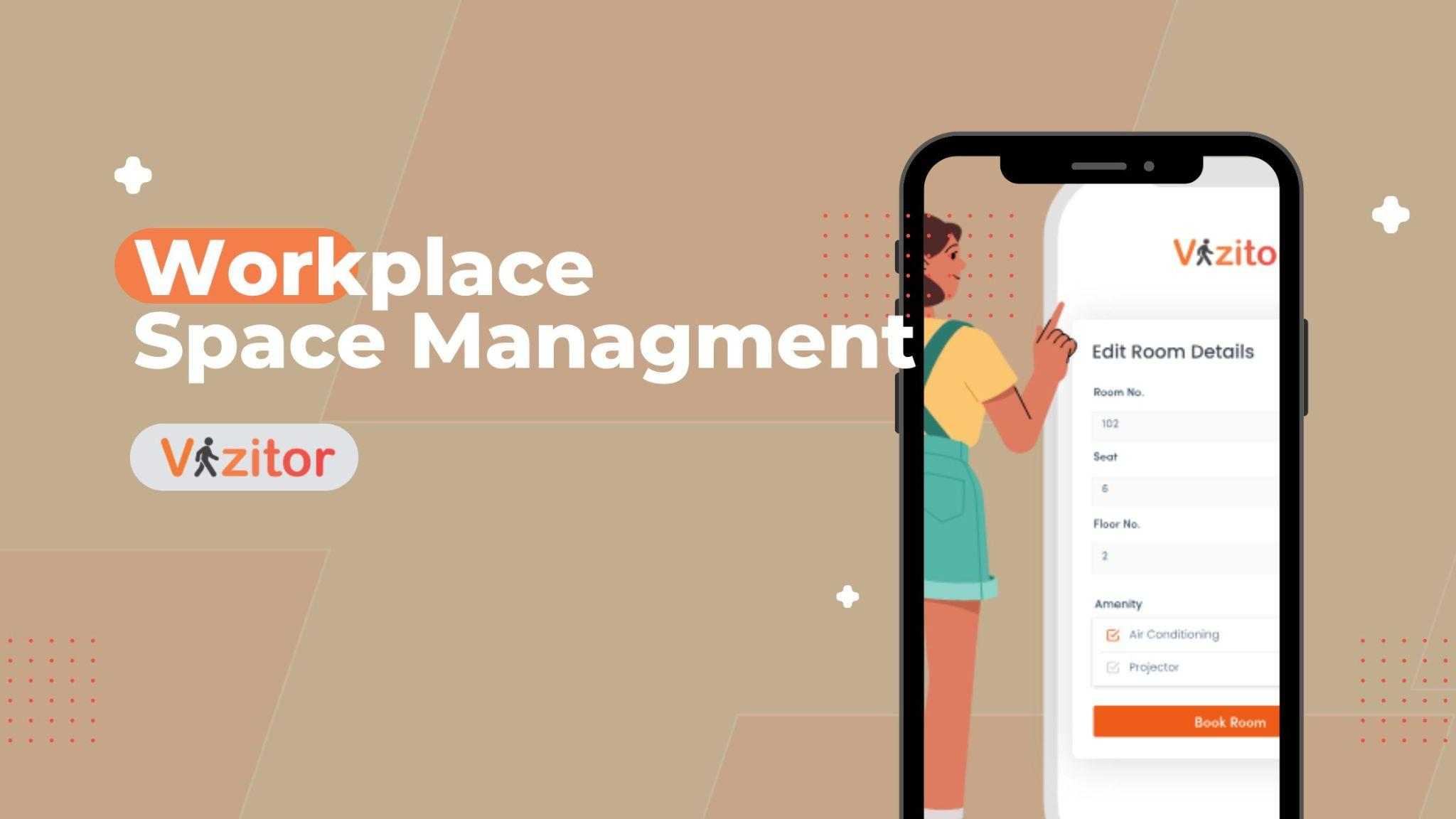Table of Content
Try Vizitor for Free!

Wed, May 22, 2024
Read in 10 minutes
Did you know that nearly 40% of office space goes unused at any given time? This surprising fact shows how important it is to manage workplace space effectively. Companies like Google lead the way by using data to see how space is used and creating flexible work areas to fit their changing needs.
Businesses can make the best use of available space to lower costs and create a more productive and collaborative environment. Good space management ensures every bit of space is used well, meeting the company’s goals and employees’ needs.
By leveraging tools such as space utilization analytics, hot-desking, and flexible workspaces, organizations can create a more adaptable and resource-efficient workplace, ultimately enhancing operational efficiency and employee satisfaction.
Let’s understand more about workplace space management.
What is Space Management?
Space management refers to the strategic planning and organization of physical spaces within a workplace or any environment to optimize functionality, efficiency, and productivity. It involves assessing and allocating space resources based on the needs of the organization and its employees.
This includes activities such as space planning, utilization tracking, allocation adjustments, and implementing design solutions to make the best use of available space. Effective space management aims to create a harmonious balance between workspace utilization, employee comfort, and operational efficiency, ultimately contributing to the overall success of the organization.
Benefits Of Workplace Space Management?
By focusing on workplace space management, organizations can improve operational efficiency, employee satisfaction, and overall business performance. Workplace space management offers several benefits to organizations:
1. Cost Savings
Efficient space management helps organizations reduce real estate costs by optimizing space utilization and avoiding unnecessary space expenses.
2. Increased Productivity
Well-designed workspaces can enhance employee productivity by promoting collaboration, reducing distractions, and providing comfortable and functional work environments.
3. Flexibility
Flexible workspace arrangements, such as hot-desking and shared workspaces, allow organizations to adapt to changing workforce needs and accommodate remote or mobile workers effectively.
4. Employee Satisfaction
A well-managed workplace that considers employee preferences and comfort can improve job satisfaction, morale, and overall well-being, leading to higher retention rates and better employee engagement.
5. Resource Optimization
Efficient space management ensures that resources like furniture, equipment, and utilities are used optimally, minimizing waste and environmental impact.
6. Enhanced Collaboration
Strategic space planning can facilitate collaboration and communication among teams by creating dedicated collaborative spaces, meeting rooms, and informal gathering areas.
7. Brand Image
A well-designed and organized workplace reflects positively on the organization’s brand image, portraying professionalism, innovation, and employee-centric values to clients, partners, and visitors.
8. Compliance and Safety
Proper space management includes adherence to safety regulations, ergonomic standards, and accessibility requirements, ensuring a safe and compliant work environment for employees.
Strategies for Effective Space Management
Effective space management is crucial for modern organizations seeking to maximize productivity, efficiency, and employee satisfaction. By strategically planning and optimizing physical spaces within the workplace, businesses can achieve significant cost savings, enhance collaboration, and create a conducive work environment.
Check out the key strategies that organizations can employ to manage their workplace space management effectively and reap the benefits of a well-designed and functional work environment.
• Space Utilization Analysis: Regularly assess how spaces are used to identify underutilized areas and optimize space allocation.
• Flexible Work Arrangements: Implement flexible work policies like hot-desking, remote work options, and shared workspaces to accommodate varying employee needs and reduce space constraints.
• Modular Furniture and Layout: Use modular furniture and adaptable layouts that can be easily reconfigured to support changing work requirements and maximize space utilization.
• Activity-Based Workspaces: Design work areas based on specific tasks and activities, creating zones for collaboration, concentration, meetings, and relaxation to improve productivity and efficiency.
• Technology Integration: Leverage technology tools such as space management software, sensors, and IoT devices to monitor space usage, track occupancy, and automate space booking processes.
• Collaborative Spaces: Create dedicated areas for team collaboration, brainstorming, and informal interactions to foster creativity, innovation, and teamwork.
• Storage Optimization: Implement efficient storage solutions like compact shelving, digital document management systems, and shared storage spaces to minimize clutter and free up valuable workspace.
• Employee Engagement: Involve employees in space planning decisions, gather feedback on workspace preferences, and create environments that support employee well-being, comfort, and productivity.
How To Work on Workplace Space Management?
By following the below steps and adopting a data-driven and collaborative approach, organizations can effectively work on workplace space management to create a productive, efficient, and employee-friendly work environment.
1. Assessment
Start by assessing your current workspace, including layout, utilization patterns, and employee needs. Identify areas that are underutilized or overcrowded.
2. Set Objectives
Define clear objectives for space management, such as optimizing space utilization, improving collaboration, or accommodating growth.
3. Data Collection
Gather data on space utilization using surveys, occupancy sensors, or workspace analytics software. Understand how different areas are used throughout the day.
4. Space Planning
Develop a space plan that aligns with your objectives and data insights. Consider factors like flexible work arrangements, collaborative spaces, and ergonomic design.
5. Technology Integration
Explore technology solutions like space management software, IoT sensors, and digital signage to automate space booking, track occupancy, and optimize resource allocation.
6. Employee Involvement
Involve employees in the space planning process to understand their preferences, work habits, and needs. Gather feedback and adjust plans accordingly.
7. Implementation
Implement the space plan, including furniture layout, signage, storage solutions, and technology integration. Ensure that the workspace is functional, comfortable, and supports productivity.
8. Monitoring and Optimization
Continuously monitor space utilization, employee feedback, and evolving work patterns. Make adjustments as needed to optimize space usage and meet changing requirements.
Challenges in Workplace Space Management
Addressing the below challenges requires a holistic approach that combines data-driven decision-making, employee engagement, technology adoption, and continuous monitoring and optimization of workspace utilization.
• Limited Space: Many organizations face the challenge of limited physical space, especially in urban areas where real estate is expensive. Optimizing the use of available space while accommodating growing teams can be a significant challenge.
• Changing Workforce Dynamics: With the rise of remote work, flexible schedules, and diverse work styles, managing space to accommodate different employee needs and preferences becomes complex. Balancing collaboration spaces with quiet zones is a common challenge.
• Technology Integration: Integrating technology solutions for space management, such as occupancy sensors, room booking systems, and digital signage, requires investment and expertise. Ensuring seamless integration and user adoption can be challenging.
• Workspace Design: Designing workspaces that promote productivity, creativity, and well-being while considering factors like lighting, acoustics, ergonomics, and aesthetics requires careful planning and expertise.
Resource Allocation: Allocating resources such as furniture, equipment, and amenities efficiently to meet varying departmental needs and employee preferences can be challenging, especially in shared spaces.
• Employee Engagement: Engaging employees in the space management process, gathering feedback, and addressing their concerns and preferences while balancing organizational goals can be a challenge.
• Change Management: Implementing changes in workspace design, layout, or policies requires effective change management strategies to ensure smooth transitions and minimize disruptions.
Future Trends in Workplace Space Management
By embracing the below future trends, organizations can create innovative, flexible, and sustainable workspaces that promote productivity, collaboration, and employee well-being in the digital age.
1. Flexible Workspaces
The trend towards flexible work arrangements, including remote work, co-working spaces, and flexible office layouts, will continue to evolve. Organizations will adopt agile workspace designs that can adapt to changing workforce dynamics and support diverse work styles.
2. Technology Integration
Advancements in technology, such as IoT sensors, artificial intelligence, and smart building systems, will enable organizations to gather real-time data on space utilization, optimize resource allocation, and create personalized work environments.
3. Wellness-Centric Design
Workplace design will focus more on employee well-being, incorporating elements like biophilic design, ergonomic furniture, natural lighting, and wellness amenities to enhance productivity, health, and happiness.
4. Data-Driven Decision-Making:
Data analytics and predictive modeling will play a crucial role in space management, helping organizations make informed decisions about space utilization, capacity planning, and workspace optimization.
5. Activity-Based Workspaces
The concept of activity-based workspaces, where employees can choose the type of workspace that best suits their tasks, will gain popularity. This includes dedicated collaboration areas, quiet zones, and flexible workstations.
6. Sustainable Practices
Sustainability will be a key focus in workspace design and management, with organizations prioritizing energy efficiency, green building certifications, waste reduction, and eco-friendly materials.
7. Virtual and Augmented Reality
Virtual and augmented reality technologies will be used for space planning, design visualization, and virtual collaboration, enabling remote teams to collaborate in immersive virtual environments.
8. Workplace Experience
The focus will shift towards creating exceptional workplace experiences, including amenities like wellness programs, social spaces, curated events, and personalized services to enhance employee engagement and retention.
What Is IWMS in Space Management?
Integrated Workplace Management System (IWMS) is a software platform that combines various modules and functionalities to support organizations in managing their real estate portfolio, facilities, and workplace operations efficiently. In the context of space management, IWMS plays a crucial role in optimizing the utilization of physical space within an organization.
Here’s a breakdown of what IWMS offers in space management:
1. Space Utilization and Allocation
IWMS provides tools for analyzing space utilization data, including occupancy rates, desk usage, meeting room bookings, and overall space efficiency. This data helps organizations make informed decisions about space allocation, redesign, and optimization.
2. Space Planning and Design
IWMS software enables organizations to plan and design their workspace layout effectively. It allows for virtual modeling of floor plans, seating arrangements, departmental allocations, and collaborative spaces, taking into account factors like team dynamics, workflow requirements, and employee preferences.
3. Occupancy Tracking
IWMS often integrates with IoT sensors and occupancy tracking technologies to monitor real-time occupancy levels in different areas of the workplace. This data helps in identifying underutilized spaces, peak usage times, and trends that influence space management strategies.
4. Workplace Experience
IWMS platforms may include features that enhance the workplace experience for employees. This can include mobile apps for room reservations, wayfinding tools, temperature and lighting controls, and feedback mechanisms to gather input on the usability and comfort of the workspace.
5. Resource Management
IWMS extends beyond physical space to manage resources such as furniture, equipment, maintenance schedules, and service contracts. It streamlines resource allocation, maintenance workflows, and vendor management to ensure optimal functioning of the workplace environment.
6. Data Analytics and Reporting
IWMS collects and analyzes data related to space utilization, costs, energy consumption, compliance requirements, and user feedback. It generates insightful reports, dashboards, and visualizations that enable decision-makers to identify trends, opportunities for improvement, and areas where resources can be optimized.
Wrapping It Up
In the world of making workspaces work better, Vizitor is like a trusted friend. It has a smart system for workplace space management that does more than just handle guests. It helps use space better and makes work areas more efficient. With Vizitor, you can see how spaces are used in real-time, manage bookings easily, and get insights from data to improve how spaces are used.
This helps create a workspace that’s not just productive but also flexible. Vizitor is easy to use, fits well with other systems, and keeps things safe and legal, making it a great choice for businesses that want to get the most out of their workspace and make employees happier.
Frequently Asked Questions
1. What is space management? Space management refers to the strategic planning and organization of physical spaces within a workplace or any environment to optimize functionality, efficiency, and productivity. It involves assessing and allocating space resources based on the needs of the organization and its employees.
2. What technologies are used in Space & Workplace Management?
Technologies such as occupancy sensors, space management software, smart building systems, and workplace analytics tools play a crucial role in optimizing space usage and enhancing employee experience.
3. What is workplace space management?
Workplace space management is the process of optimizing and efficiently utilizing physical workspace within an organization to support business objectives and enhance employee productivity.








